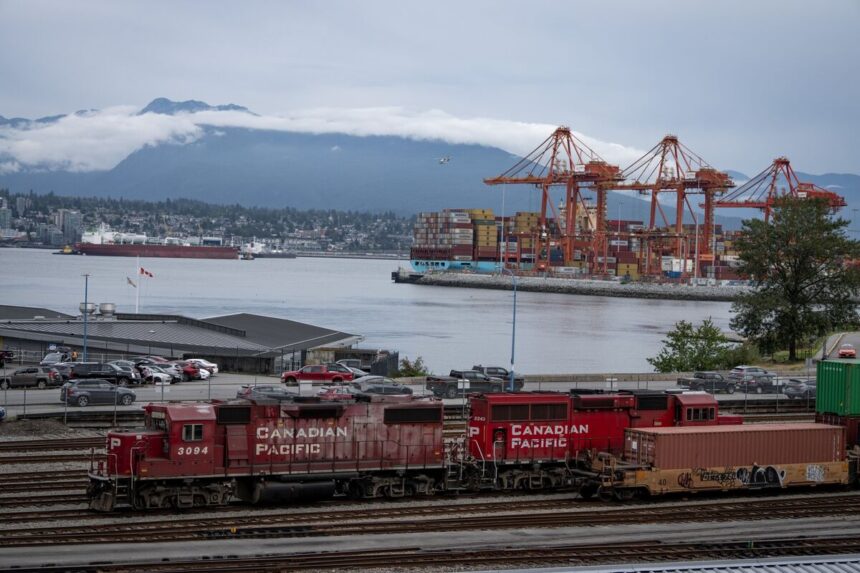I just spent three days crisscrossing Toronto’s financial district, where Canadian banking executives are quietly war-gaming scenarios that few investors seem prepared for. While Bay Street’s glass towers project confidence, behind closed doors, a palpable anxiety is building around what Donald Trump’s return to the White House might mean for the world’s longest undefended border – and the $2.6 billion in goods that cross it daily.
“We’ve been modeling potential impacts of a 10-25% tariff scenario, and frankly, the markets aren’t pricing this in yet,” Benjamin Tal, CIBC’s Deputy Chief Economist told me during an interview at the bank’s headquarters. “This represents a structural risk to Canada’s economy that could materialize faster than people realize.”
The disconnect is striking. Despite Trump’s consistent campaign messaging about imposing broad tariffs, including specific mentions of Canada alongside China and Mexico, Canadian equities and the loonie haven’t reflected this existential threat to an economy that sends nearly 75% of its exports south.
My conversation with Tal came just hours after CIBC released a comprehensive report warning that these potential tariffs could slash Canadian GDP growth by up to 1.8 percentage points if implemented at the higher end of Trump’s proposed range. The bank’s analysis suggests several sectors would face immediate pressure, with automotive manufacturing, aluminum, and forestry products most vulnerable.
Walking through Toronto’s Path system – the underground network connecting the financial district – I met with three portfolio managers who all expressed similar concerns about market complacency. “It’s as if investors are treating Trump’s tariff talk as negotiating rhetoric rather than actual policy intentions,” said Martin Ferguson at RBC Global Asset Management, who requested I not use his real name given the political sensitivity.
Data from the U.S. Trade Representative’s office shows the Canada-U.S. trading relationship generated approximately $809 billion in total goods and services trade during 2023. Any disruption to this flow would have immediate ripple effects throughout supply chains that have become deeply integrated since NAFTA’s implementation nearly three decades ago.
The Bank of Canada, which I visited yesterday, remains publicly cautious about commenting on hypothetical policy scenarios. However, a senior official speaking on background acknowledged they’ve been stress-testing various outcomes. “The challenge is balancing preparation without creating unnecessary market panic,” the official explained.
According to Statistics Canada, approximately 1.7 million Canadian jobs directly depend on exports to the United States. When including indirect employment effects, that number climbs significantly higher.
Outside economic circles, I found surprisingly little public discussion of these risks during conversations at a manufacturing facility in Mississauga yesterday. Plant manager Robert Chen shrugged when I asked about potential tariffs. “We’ve heard this before. Until something actually happens, we’re focused on today’s problems.”
This disconnect between economic warning signs and market behavior mirrors what I observed during the first Trump administration’s NAFTA renegotiations. Markets remained relatively calm until specific policies materialized, then reacted sharply to developments.
“There’s historical precedent here worth considering,” explained University of Toronto economics professor Amelia Richardson. “When the U.S. imposed aluminum tariffs in 2018, Canadian producers saw immediate impacts despite the eventual resolution.”
The loonie’s current trading range against the U.S. dollar suggests currency markets haven’t fully incorporated this risk premium. According to CIBC’s analysis, the Canadian dollar could depreciate by 5-10% if substantial tariffs were implemented, providing some natural offset to Canadian exporters but creating inflationary pressures domestically.
On Parliament Hill in Ottawa last week, government officials were reluctant to discuss specific contingency planning. “We’re engaged in ongoing discussions with stakeholders across sectors,” said a spokesperson for the Ministry of International Trade, offering the kind of vague reassurance that typically masks more intense behind-the-scenes activity.
For ordinary Canadians, these high-level economic discussions translate to real pocketbook concerns. CIBC estimates that significant U.S. tariffs could raise consumer prices by 1-2 percentage points annually as import costs rise and supply chains reconfigure.
The history of U.S.-Canada trade disputes suggests resolution pathways exist, including potential exemptions, negotiated quotas, or legal challenges through remaining trade agreement mechanisms. However, Trump’s previous willingness to invoke national security justifications for tariffs – a move that largely circumvented traditional trade remedy processes – creates additional uncertainty.
“Markets tend to dismiss risks until they materialize,” Tal noted toward the end of our conversation. “That’s precisely why this warrants attention now, before portfolios need emergency repositioning.”
As I boarded my flight back to Washington last night, I couldn’t help but notice the irony: two nations sharing the world’s most successful bilateral trade relationship now face a potential disruption that few seem prepared to confront directly. Whether this represents strategic silence or dangerous complacency remains to be seen.






